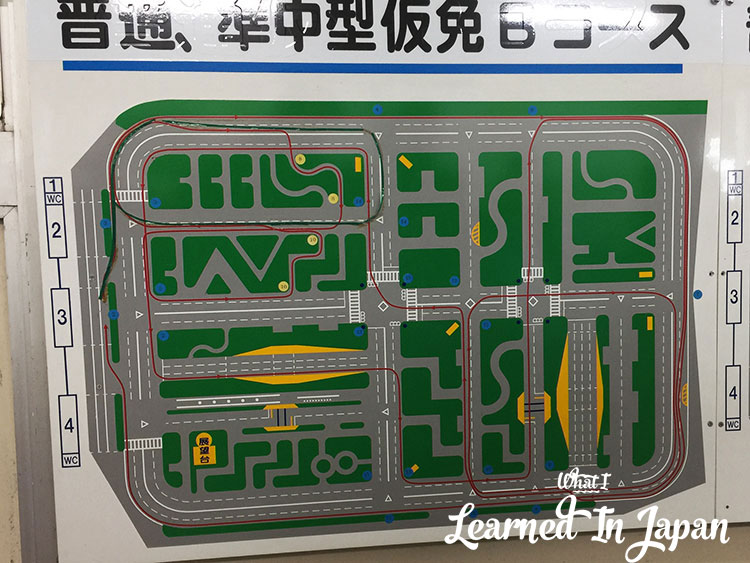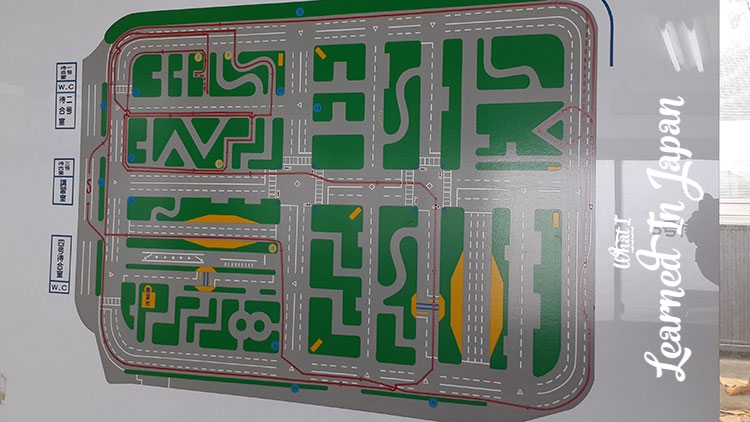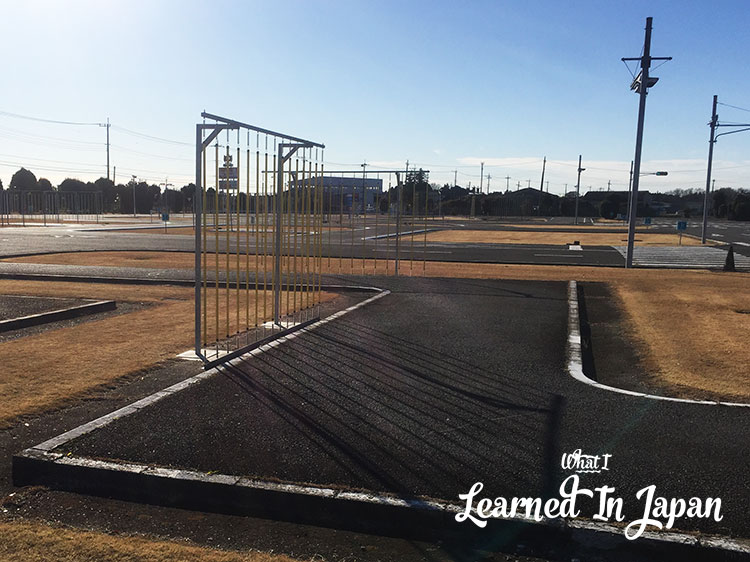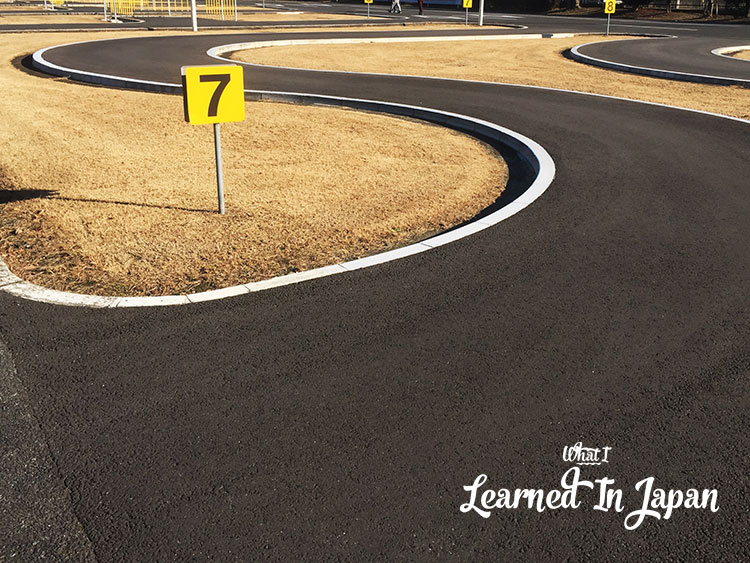

The courses seem to be randomly chosen before the day starts so don’t copy these photos and think this will be your course. They are similar but will most likely have different routes depending on the proctor and the course.
A very helpful advice is to walk the course and imagine how you will drive. Run what you would do in your head as you approach every turn.
For example, know where to slow down to make the turn, know when to shift to lower gear, know where to slow down again, etc.
There will be many markings/ references on the road i.e. trees, numbers, and etc. which you could use to your advantage. This is probably your biggest advantage you have to familiarize yourself before actually driving the course.
Table of Contents
Make obvious movements with your body as you look to turn!
When driving, you must exaggerate your movements when looking.
The moment you are in the driver’s seat of the car, you are required to show you are looking around.
Look around with big obvious movements. To clarify, when you look to the side, don’t just move your eyes; turn your head, extend your neck, and twist your body from the hip to the direction you want to look at.
Call Out your Actions Orally (optional but really helps)
It’s better to call out your actions than to say nothing as you drive.
For example: “Side mirror check, rear mirror check, seat belt check, pedestrian crossing check, slow sign ahead, etc.”. (better if spoken loud and in Japanese).
A friend of mine once failed because the proctor said she forgot to look over her shoulder at a turn. However, another test taker who sat behind her said she did look over her shoulder at that turn. Either the proctor wasn’t paying attention or someone is lying. People aren’t perfect so call it out and do it.
The proctor has the power of authority but are not perfect. Call out what you are going to do and do it so the proctor will be visually and acoustically stimulated.
Hug the Left side of the Road
Always stay on the left side of the road and hug it even further without falling off the road or hitting the curb. Try to lean towards the left side of the lane when driving.
This part to me is one major characteristic of the Japanese way of driving.
Remember that a car in Japan is supposed to never be exactly in the center while on the road; it should always be near to the left. This also goes for parking in the end of the test.
This is not hard to do but many people get this wrong and fail due to this simple infraction especially for foreigners.
Pump the brakes before slowing down or entering a curve.
Instead of pressing the brakes to slow down, pump the brakes at least twice before entering a curve or for slowing down. It will not be smooth but it shows what you are doing to control the car to a slow. If you drive manual, use the brakes and the lower gear (engine brakes) to slow down.
Always signal before every turn.
In Japan, you must signal at least a 100 feet (30 meters) before making a turn or switching lanes. You don’t need to turn on your signal at the curves or where the road has nowhere else to go such as the S-curve or Crank.
If I remember correctly, my turn signal was on most of the time during the test. The moment the proctor said turn in to number 8, my turn signal was already on.
Keep Both Hands on the Wheel at all Times.
Keep your hands on the steering wheel at all times. If you are driving manual, your left hand lets go of the steering wheel only when you shift gears. When you turn the wheel, do hand over hand. Do not cross your hands or something fancy.
A friend of mine actually failed this part as she kept his left hand on the gear stick while driving. She put style over safety.
Don’t do the 12 and stick like those punk college jocks. Just stick to the basics.
Lean to the Left and Lean to the Right when turning or switching lanes.
This is also another part where many of us fail. You must lean to the far left of your lane before making a left turn or making that left lane switch.
You must lean to the right of the lane before making that right turn.
So for example, if you were to make a left turn into the crank section, this is what you do in the right order:
- Signal to the left
- Lean to the left
- Look at your left side mirror
- Look over your left shoulder
- If clear, execute the turn.
In other words, your left turns should always be tight.
Another example if you were to make a lane switch to the right. This is what you do:
- Signal to the right.
- lean to the right side of the lane
- look at your right side mirror
- look over your right shoulder
- if clear, execute lane switch.
The main reason why we must lean to the left side before turning to the left is because it not only lets other motorist know you will make a left turn and make it easier for them to pass you from behind but it also narrows the path of motorcyclists and bicycles traveling at your left side so they don’t go ahead of you.
Motorcyclists and bike riders upon seeing you lean to the left will be forced to slow down and wait behind you for you to turn before moving on… thus avoiding collision.
Always Look Behind when Making a Turn.
When you make a left turn, look right, look left, and look back and left! When making a right turn, look left, look right, and look back and right with your head going over your shoulder all the time.
The reason to doing this is that when bikers and pedestrians are present they are less visible behind us because they come from behind. We must watch out for them all the time when making turns into a road especially on narrow roads.
In Japan, many auto to pedestrian accidents occur when a car is turning into a road. Drivers that don’t check the sidewalks (behind to their left or right) don’t see the pedestrian about to cross. When driver’s make that turn without looking, they could be headed into a disaster.
Pedestrians always have right of way.
If a car strikes a pedestrian, the driver is automatically at fault here.
If you kill the pedestrian, you go to prison and pay a hefty fine.
Not paying attention to your surroundings can cost your life and the life of others. Don’t mess with this part! This tip might save your life and the life of others!
*Almost every proctor vigilantly watches for this and may fail you even if you forget to look over your shoulder just once (even if you did everything right)! Looking over your shoulder before making a turn into a road is a good driving habit to learn esp. in Japan.
If you can’t get this part right, you are a ticking time bomb to many pedestrians out there.
Looking over your shoulder before a turn is a good habit to keep even after you have a driver’s license in Japan. Looking over your shoulder before making any turn or lane switch is a good driving habit regardless if you’re in Japan or not.
When you stop, MF’in STOP.
When you approach a stop sign, you must make a FULL STOP behind the stop line. Don’t F’n roll like they do in California. You should stay stationary for at least 3 seconds before proceeding.
If you don’t stop at a stop sign, you automatically fail. This is not hard to do but for some reason, many people fail this part!!!
Obstacles
Remember that your number one job as a driver is to not hit anything in front of you. There will be obstacles on the course.
There can be a parked car, cones, or another test taker making a right turn in your lane.
When presented with an obstacle this is what you do:
- signal first
- if needed slow down
- look into the side mirror
- look over your shoulder
- when clear execute the lane switch if not clear, stop at most 10 meters from obstacle until it is safe to move to another lane.
Remember that once you move to another lane, you must go back to your original lane. So this is what you do:
- Check your side mirror.
- Look over your shoulder.
- If clear return back to your lane. If not do not proceed. Repeat the process until clear to do so.
The Crank
To be honest, this is actually easier than it looks. The crank is a narrow road that looks like a crank shaft with two to three right angle turns. These are sharp turns you must make without hitting the curb or poles.

When entering the crank, you usually enter from the left from a wide main road. You must lean and keep the left turn tight as you enter the crank. If you don’t do this, you will get points docked off.
Once in the crank, take your time. Take it as slow as you can. Before making a left turn in the crank, stay as far right as you can before making that left turn. If you think you will hit the obstacle, stop, then back up and correct your angle of approach.
My main advice here is to feel it and go through it with instinct.
The S Curve
The S-curve is a narrow strip of road that is shaped like an S.

Again, go slow and use your instincts. When you start the S-curve stay more to the right when turning to the left. Stay more to the left when turning to the right. Again just feel it! Like the crank, you are allowed to reverse up to three times during or before making a mistake so take it slow and show you have control of the vehicle.
Chiba prefecture is the only place I know that fails your for hitting the curb (or falling off the road) during the S-curve and Crank.
Finishing Up
Listen to the instructor very carefully on where he/she wants the car to be parked.
A friend of mine failed because he didn’t understand what the proctor was saying and parked the car past where the proctor wanted the car to be at.
Another failed because he parked the car too far to the right when it should have been more to the left.
Finishing It Off
When you park the car. Put the car in “P” with the hand brake up and turn off the car. For manual drivers, put the car in 1st or Reverse gear with the handbrake on.
Once finished, the proctor will either tell you if you passed or failed. If you passed, the proctor will probably say Good or OK. I was actually told “yoku dekimashita!”
If you failed, he/she will give you back driving papers and go over everything you did wrong. The proctor will give you further instructions on where to go to make a reservation to retake the test.
In some places, some people had to wait up to three months to retake their test… don’t be surprised as some people have been retaking the test for a year or more.
Other things to note:
- Take the entire course slow but not too slow. The fastest you will be traveling is 40 kph and that is just on a short strip. Most parts of the course will be around 15~30 kph. There are also sections where you must go really slow around 10 kph or less so keep that in mind and take it slow.
- When passing a high wall or bush, slow down. Slow in Japan is about 10 kph and less. You must be traveling at a speed where you can stop within one meter if a kid, dog, or person were to pop out of nowhere.
- Don’t go passed over white lines. You can have your tire on the white line but do not fully pass over it.
- If the proctor tells you to speed up, speed up a little. Some people have failed for going too slow the entire course.
- If you are driving a manual car, make sure to brake first before downshifting to use your engine brake to slow down. If you know how to heel and toe, go for it but always follow the rules on the road.
- Actively use your side mirrors to see the how far your car is from the side lines. Remember to stay as close as possible to the left line of your lane.
- Use your side brake during the hill. The proctor will tell you to stop right before reaching the top of the hill. If you are driving automatic, you have nothing to fear. However if you drive manual, make sure you do not roll back. If you activate your side brake you won’t roll back even if you step off the foot brake. With the side brake activated, let the clutch out a little and give a little gas. When you feel a little movement going forward, release the side brake and off you go. Do not use the clutch to hold the car on the hill.
- In the end, make sure to follow the instructions of the proctor. If he tells you to park between the poles, park between the poles. Make sure you lean towards the left as you park.
- When parking the car, put the car in park, pull up the hand brake, and turn off the car.
- When parking a manual car, turn off the car while in neutral, pull up the brake, then put the gear in reverse or in 1st gear.
- When approaching a railroad crossing, stop, roll down a window, listen, look both ways, then proceed.
- At crosswalks, stop if there is a pedestrian. Go slow otherwise but call it out that there is no one crossing.
- Watch both front and back before exiting a car.
- Remember each proctor knows their stuff. They are not just police officers but highly skilled drivers of all types of vehicles they test for. They really know their stuff.
- Know thy enemy and know thy self. Feel out your proctor and the car. Know what you are capable of and do what you know. As a driver from the U.S., you should be able to pass with your basic knowledge of driving. If you don’t succeed the first time, learn what you did wrong and try again.
Failure to do any of these above may result in you failing. If you do fail somewhere along the beginning section of the course, the proctor may be kind enough to let you continue to drive the entire course regardless so you can learn. If you aren’t lucky, the proctor will tell you to make a U-turn and drive back to the starting point after committing the major infraction. I think this goes for people who failed for more than 3 times.
Common Fail Reasons
- Too fast on the slow sign
- not stopping at the line of the stop sign
- no feeling for control (You must control the car; the car does not control you)
- driving with the handbrake on (forgetting to put the handbrake down)
- going over the instructed speed limit
- not signalling when making a turn
- not being vigilant enough when driving
- not looking over shoulders when turning
- not being far enough to the left.
- not being far enough to the right when turning right.
- not checking the exterior and underside of the car before starting
- rolling back on the hill (manual cars)
- rolling forward when reversing (manual cars)
- being too arrogant with your skills
- having no confidence
- being an asshole
I hope this guide helps. If you have any questions, please feel free to ask. If you have and suggestions, please feel free to share in the comments below!


I remember while waiting to take my practical test, a translator for an actual test taker asked a question after the interpreter was not allowed to ride in the car during the practical test. The question to the proctor was, “how can he understand if I’m not with him?” The proctor bashed angrily at the translator by saying, “your client lives in Japan right? That person wants to drive in Japan right? Then he must be able to understand and communicate in simple Japanese at the very least.” The proctor then continued, “in the case he ever gets into an accident with someone or is pulled over by police he must be able to understand Japanese and be able to communicate on his own, because he is in Japan.”
I actually agreed with the proctor on this one because it’s “When in Rome”. You gotta play with their rules!